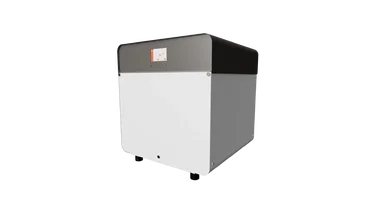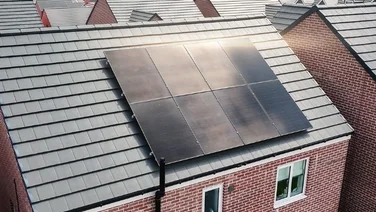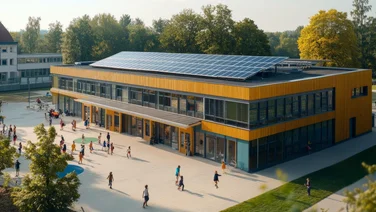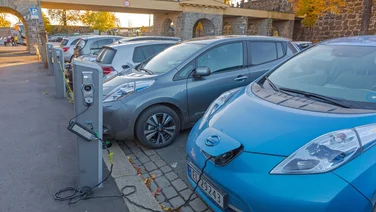- Green Deals refer to policies that address environmental challenges
- They focus on tackling climate change, promoting sustainability, and ensuring sustainable economic growth
- Notable examples include the European Union’s Green Deal, the UK’s Green Deal, and the US’ Green New Deal
- Each one has specific goals, but they generally emphasise renewable energy, energy efficiency, and reducing greenhouse gas emissions

Water droplets on leaves- credit: Sergio Boscaino/Wikimedia Commons
Green Deals are government schemes designed to help homeowners and businesses improve their energy efficiency through grants and funding mechanisms that help reduce the upfront investment costs.
What is a Green Deal?
‘Green deals’ refer to a set of government, sometimes international, policies and initiatives to address environmental challenges and promote sustainability.
The most notable ones are the European Union’s Green Deal, launched in 2019, the United Kingdom’s ‘Green Deal,’ which ran from 2013 to 2015, and the United States’ ‘Green New Deal,’ proposed in 2019. We’ll discuss these separately later, but they reflect a commitment to tackling climate change, promoting sustainability, and ensuring economic growth that benefits all sections of society.
While the Green Deal might sound like a buzzword, existing and former examples have wide-reaching ambitions that can significantly impact societies and economies where proposed.
For this reason, we have put together this guide to explain everything in as much detail as possible.
The UK’s Green Deal

The UK’s “Green Deal” ran from 2013 to 2015 – credit: Ian Calderwood/Wikimedia Commons
Initially launched in 2013, the United Kingdom’s Green Deal was a government initiative designed to help homeowners and businesses make energy-saving improvements to their properties.
Its core principle aimed to improve energy efficiency without requiring upfront payment, allowing costs to be repaid through savings on energy bills. This was called the ‘Golden Rule’ and was the essential criteria for a particular green deal plan to be deemed viable.
The UK’s Green Deal built on the existing concept of Energy Performance Certificates (EPCs) with an added ‘Occupation Assessment’ (OA) to assess the viability of energy efficiency and renewable technology improvements like insulation or solar panels.
This OA was designed to accurately assess the home occupiers’ energy use in a particular property and capture vital information like fuel bills and their energy habits throughout the year (like the hours they were at home, preferred thermostat settings, etc.).
This data was then number crunched to assess which measures the occupier would benefit from to cut their energy bills. Based on this, unique financial products were proposed to fund energy-efficient upgrades such as insulation, heating systems, and renewable energy installations.
The loan cost was then paid back through the occupier’s energy bills over a fixed period. The Golden Rule meant, however, that the price after work was completed with the cost of finance must be less than the fuel bill before the works.
The scheme was ultimately scrapped in 2015 when government support was withdrawn. This was for various reasons, but low uptake from the population and concerns arising around the quality of workmanship. Although government funding has been withdrawn, you can still apply for the scheme through private companies.
Was the UK Green Deal a success?
In short, no. But it did raise interest in home energy efficiency improvement and upgrades, albeit for a short time.
It also briefly boosted employment opportunities for the Greentech sector, with a large cohort of Green Deal Assessors needed yesterday to make the scheme work. To this end, existing professionals or novices got qualified by topping up existing qualifications (like EPC assessors) or training from scratch. This saw a brief explosion in training companies offering official routes to qualification and training.
The scheme also temporarily created new business opportunities for assessors and ‘Green Deal Adviser’ organizations that would assist homeowners in drawing up and completing the finance packages. There was a also a boom in qualified and accredited green deal installer companies offering to do the works required.
What are the UK government’s current economic policies?
Although the UK’s official ‘Green Deal’ has ended, several existing economic policies are in place to help promote energy efficiency and reduce reliance on fossil fuels. The first is the overarching Net Zero Strategy. As the name suggests, this commits the UK government to achieving net-zero greenhouse gas emissions by 2050.
Further to this, some of the most notable financial policies and incentives include but are not limited to:
- The Green Homes Grant: This program provided homeowners vouchers to help cover the cost of energy-efficient improvements like insulation and low-carbon heating.
- ECO (Energy Company Obligation): Energy suppliers must help households reduce their energy consumption through efficiency measures.
- Renewable Heat Incentive (RHI): This incentive provides financial support for using renewable heat technologies in homes and businesses.
Various other policies aimed at transportation (like notional bans on combustion engines), industrial decarbonization (carbon capture, commitment to nuclear energy), biodiversity promotion, and natural environment protection (i.e., the 25-year Environmental Plan and reforestation/wilding policies).
National Home Energy Survey 2024
Find out what the UK public really thinks about low-carbon technology, the environment and government policy on climate change in the National Home Energy Survey 2024.

Overview of EU Green Deal – credit: European Union
The EU’s Green Deal
The European Union’s ‘Green Deal’ is a comprehensive framework designed to transform the EU’s economy for a sustainable future. It aims to set the EU on the path to a green transition and reach climate neutrality by 2050.
The core principles of it include, but are not limited to:
- Climate Neutrality: The EU is gearing up to be net-zero greenhouse gas emissions by 2050.
- Economic Growth Decoupled from Resource Use: This promotes economic growth without corresponding increases in resource consumption and environmental degradation.
- Inclusive Transition: This is designed to ensure the transition to a green economy benefits all regions and sectors, particularly those most affected by the shift.
How does the EU’s ‘Green Deal’ work?
The European ‘Green Deal’ also covers several key areas and actions. These include but are not limited to, transitioning to renewable energy sources (wind, solar, hydro), improving energy efficiency, and integrating energy systems across the EU.
It also seeks to support industries transitioning to cleaner production processes and the circular economy.
Another key part of it is promoting building energy performance. This includes the ‘Renovation Wave’ initiative to enhance building energy efficiency.
The scheme also includes a key element of creating a fairer, healthier, and more environmentally friendly food system. This also includes an emphasis on protecting and restoring ecosystems and biodiversity.
Other elements include reducing pollution and promoting a shift to cleaner, healthier modes of transport. The EU’s “Green Deal” also hopes to promote funding and research for the green transition.

Image of U.S. Representative Alexandria Ocasio-Cortez giving a talk about the “Green New Deal” – credit: Senate Democrats/Wikimedia Commons
US – Green Deal
The ‘Green New Deal’ refers to a series of policy proposals addressing climate change and promoting investment in renewable energy. The concept was popularized by Pulitzer Prize-winner Thomas Friedman in 2007 and later incorporated into various political platforms, including those of former President Obama and Green Party candidates.
The ‘Green New Deal’ resolution introduced in 2019 called for a 10-year national mobilization to address climate change and economic inequality. It proposed significant investments in renewable energy, upgrading infrastructure, and promoting sustainable agriculture and transportation.
The ‘Green New Deal’ aims to achieve net-zero greenhouse gas emissions in the U.S. by 2030 and meet the country’s power demand through clean, renewable, and zero-emission energy sources. It emphasizes job creation, clean air and water access, healthy food, and a sustainable environment.
Key components include investments in renewable power, upgrading buildings for energy efficiency, supporting sustainable farming, and developing zero-emission transportation systems.

Solar panels being installed in Shanghai credit: Climate Group/Flickr
Green deals in Asia
In late 2020, China, the world’s largest developing country, committed significantly to addressing climate change by pledging to reach net-zero emissions by 2060. This commitment marks a major shift for China, whose industrial economy relies heavily on fossil fuels.
Japan also made a notable shift in its climate change policy in 2020. Previously criticized for its lukewarm response to climate change, Japan pledged in October 2023 to achieve carbon neutrality and an 80% reduction in emissions by 2050. This pledge is supported by Japan’s most potent business federation, which includes many energy-intensive industries, indicating a significant change in corporate attitudes towards climate action.
South Korea, another country heavily reliant on fossil fuels, committed in October 2022 to achieving carbon neutrality by 2050. However, South Korea faces significant challenges, as its capital city, Seoul, still generates 40% of its electricity from coal. This highlights the long road ahead for the country in transitioning to renewable energy sources.
New Zealand declared a ‘climate change emergency’ in the Pacific and committed to maintaining a carbon-neutral government by 2025. This announcement underscores New Zealand’s proactive stance on climate action and its commitment to leading by example in the fight against climate change.

Various technologies will be vital for any “Green Deal” to be a success – credit: Picryl
What technologies are needed to make Green Deals work?
As you can imagine, all the usual subjects like solar, wind, and hydro are typically promoted under most global ‘Green Deal’ proposals. However, other technologies will prove vital to ensuring the long-term success of any ‘Green Deal’ in any nation. These include biomass and bioenergy technologies that convert organic materials into heat and power. Geothermal energy will also play a huge role.
But generating energy is only part of the story. It will also be essential to store excess energy where possible. For this reason, battery storage, pumped hydro storage, and thermal storage technologies will also have their part to play. Beyond that, emphasis is typically put on reducing the energy nations need. For this reason, the energy efficiency of everything from your home to your computer will also be necessary.
Smart energy grid investment will also be needed to distribute power on demand more intelligently, and increased reliability will be vital, too. Other sectors, such as transportation, will also need attention. This will benefit electric vehicles, hydrogen fuel cells, and emission-free public transportation.
Beyond those things, digital transformation will also play a role, with the Internet of Things (IoT), Big Data, and artificial intelligence (AI) becoming increasingly important. Agriculture, land use, water quality, air quality, and waste management improvements will also see something of a revolution with the political will and investment required.
Do people think green deals work?
Despite governments across the world putting huge amounts of money into green deals and other sustainability-related efforts, the public remans sceptical as to how effective they can be.
According to the 2024 National Home Energy Survey, 39% of the British public did not believe that a change in government would make a meaningful difference to the country’s efforts to cut emissions, saying that parties of all sides hadn’t done enough.
Summary
- “Green Deals” worldwide represent a significant shift towards sustainable development and climate change mitigation.
- While the UK’s “Green Deal” faced challenges, it sparked interest and temporary employment growth in the Greentech sector.
- The European Union’s ‘Green Deal’ offers a comprehensive framework for climate neutrality by 2050, promoting economic growth decoupled from resource use.
- The US ‘Green New Deal’ focuses on achieving net-zero greenhouse gas emissions by 2030 through substantial renewable energy and infrastructure investments.
- Global ‘Green Deals’ require technological advancements in renewable energy, energy storage, and smart grid investment to achieve long-term success and environmental sustainability.







